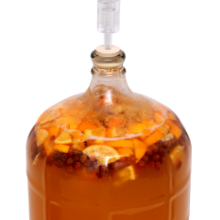Mead Making Tips and Recipes
Mead Making Tips and Recipes

What is Mead?
Mead (often called "honey-wine") is an ancient alcoholic beverage made by fermenting a mixture of honey and water. It is considered by many to be the earliest fermented beverage ever created. It has historical roots in many different countries all over the world. There is archaeological evidence to support the production of mead as far back as 2,000 BC. Early home brewers would mix rainwater with honey and allow the mixture to ferment. Often, other ingredients were added to complement the flavor. Depending on the spices, fruits, or grains added, mead can be carbonated or still, and can range from dry to sweet.
Honey for Meads:
Almost any fresh honey will work well. The preservatives in processed honeys have been known to inhibit mead/wine yeast! The pollen in honey gives character to the mead. Most processed honey is filtered thus removing its pollen and character. We prefer raw, unheated, unfiltered, unadulterated, straight from the hive honey.
Necessary ingredients:
- Good quality honey (no preservatives)
- Good drinking water (no distilled water, no chlorine!)
- Acid (as the recipe requires)
- Yeast Nutrients (very important, yeast needs nutrients for a vigorous healthy fermentation)
- Tannin (as the recipe requires)
- Yeast (wine or mead yeast works best)
Keep all equipment clean and sanitized!
Sterilizing your honey can be done one of 2 ways:
- Add campden tablets (a sulphite) to the honey must ("must" is a term for a mixture before and during fermenting). This should be done a day before you add yeast
- Boiling the honey must (honey/water before fermenting). This method is only reccomended if you cannot find sulphite tablets, as you will lose a lot of wonderful flavor during the boiling process.
We prefer the campden tablet method.
Ferment like regular wine.
A glass container is the best choice to ferment in. A food grade plastic bucket is alright for the first month, as long as you then transfer to a glass jug. Keep a constant temp of about 70' to 75' F. Transfer to a clean glass jug once a month for the first 3 months. After that, transfer when the mead off of any layer of yeast or sediment build up.
Bottling
When the fermentation has completed, the mead has cleared, and bubbles are not visible, it is time to bottle. You may have to wait a full year before bottling. If you bottle too soon, you might have alot of sediment which will detract from the mead.
Sparkling meads:
For sparkling meads, you will ferment like a traditional mead. When it comes time to bottle, add 3/4 cup of dissolved corn sugar in a cup of water for every 5 gallons of mead. Also, stir in a package of fresh yeast. Pour into beer bottles and cap. It will take about 1 month for the mead to carbonate.
Meads and Mead Variations
Traditional Mead:
Only honey and water are used. No fruit or spices are added.
Sack Mead:
Sack mead is similar to the traditional mead, although 20 to 25 % more honey is added. It should have a honey aroma when the bottle is opened, be careful not to add too much honey.(too much honey makes the mead too sweet)
Metheglyn
A mead made with Gruit(a combination of herbs). This style was very popular during the Middle Ages.
Sack Metheglin:
A Metheglyn made with a bit more honey.
Clarre or Pyment:
Honey and grape juice fermented creates a fruitier flavor. This variety was also quite popular in the Middle Ages.
Cyser:
Apple juice or cider fermented with honey is known as cyser.
Melomel or Mulsum:
Ferment honey and fruit juice (other than apple or grape). This was a popular Roman drink.
Morat:
Morat is made with honey and mulberries.
Mead Recipes
Sample recipes: for 1 gallon batches
Dry Mead
| 2 1/2 pounds Honey | Any pure honey should work well. |
| 7 pints water | high quality drinking water (not distilled) |
| 3 tsp. Malic Acid | |
| 1 1/2 tsp. Tartaric Acid | |
| 1/4 tsp. Tannin | Tannin is very strong, so be careful not to over use it! |
| 1 tsp. Yeast Nutrient | Yeast need nutrients to work well, otherwise your fermentation might be slow or not start at all. |
| 1 Campden Tablet (crushed) | Campden tablets are a measured amount of sodium or potassium metabisulphite. They are used to sanitize your honey. Add tablets 1 day before yeast. |
| 1 pkg. wine or mead yeast | For best results, use high quality wine or mead yeast. |
Sweet Mead
| 3 1/4 pounds Honey | Any pure honey should work well. |
| 7 pints water | high quality drinking water (not distilled) |
| 3 tsp. Malic Acid | |
| 1 1/2 tsp. Tartaric Acid | |
| 1/4 tsp. Tannin | Tannin is very strong, so be careful not to over use it! |
| 1 tsp. Yeast Nutrient | Yeast needs nutrients to work well, otherwise your fermentation might be slow or not start at all. |
| 1 Campden Tablet (crushed) | Campden tablets are a measured amount of sodium or potassium metabisulphite. They are used to sanitize your honey must (honey/water before fermenting). Add tablets 1 day before yeast. |
| 1 pkg. wine or mead yeast | For best results, use high quality wine or mead yeast. |
Melomel
| 2 1/2 pounds Honey | Any pure honey should work well. |
| 2 pounds of Fruit or 2 pt Fruit juice | no sugar added |
| 6 pints water | Good quality drinking water (not distilled) |
| 3 tsp. Acid Blend | |
| 1/2 tsp. Pectic Enzyme | Helps removes the pectin from the wine. |
| 1 tsp. Yeast Nutrient | Yeast needs nutrients to work well, otherwise your fermentation might be slow or not start at all. |
| 1 Campden Tablet (crushed) | Campden tablets are a measured amount of sodium or potassium metabisulphite. They are used to sanitize your honey must (honey/water before fermenting). Add tablets 1 day before yeast. |
| 1 pkg. wine or mead yeast | For best results, use high quality wine or mead yeast. |
Pyment or Clarre
| 1 1/2 pounds Honey | Any pure honey should work well. |
| 1 pt White Grape conc. or 2 pounds Lt. raisins | |
| 6 1/2 pints water | high quality drinking water (not distilled) |
| 3 tsp. Acid Blend | |
| 1/8 tsp. Tannin | Tannin is very strong, so be careful not to over use it! |
| 1 tsp. Yeast Nutrient | Yeast needs nutrients to work well, otherwise your fermentation might be slow or not start at all. |
| 1 Campden Tablet (crushed) | Campden tablets are a measured amount of sodium or potassium metabisulphite. They are used to sanitize your honey must (honey/water before fermenting). Add tablets 1 day before yeast. |
| 1 pkg. wine or mead yeast | For best results, use high quality wine or mead yeast. |
Metheglyn
| 3 pounds Honey | Any pure honey should work well. |
| 4 Cloves 1/2 oz Ginger root 1 oz Elder flowers * (optional) | |
| 7 pints water | high quality drinking water (not distilled) |
| 3 tsp. Acid Blend | |
| 1 tsp. Yeast Nutrient | Yeast needs nutrients to work well, otherwise your fermentation might be slow or not start at all. |
| 1 Campden Tablet (crushed) | Campden tablets are a measured amount of sodium or potassium metabisulphite. They are used to sanitize your honey must (honey/water before fermenting). Add tablets 1 day before yeast. |
| 1 pkg. wine or mead yeast | For best results, use good quality wine or mead yeast. |
Queen Elizabeth's Mead / Metheglyn
| 3 pounds Honey (heather honey if possible) | Any pure honey should work well. |
| 1 gallon of water | Good quality water (not distilled) |
| 1/4 oz. Tartaric Acid | |
| 1/2 oz. Malic Acid | |
| 1 tsp. Yeast Nutrient | Yeast needs nutrients to work well, otherwise your fermentation might be slow or not start at all. |
| 1/8 tsp. Tannin | Tannin is very strong, so be careful not to over use it! |
| 1 Campden Tablet (crushed) | Campden tablets are a measured amount of sodium or potassium metabisulphite. They are used to sanitize your honey must (honey/water before fermenting). Add tablets 1 day before yeast. |
| 1 pkg. wine or mead yeast | For best results, use good quality wine or mead yeast. |
| 1/2 oz. Rosemary 1/2 oz. Bay Leaves 1/2 oz. Thyme 1/4 oz. Sweet Brair | After wine is about 3 - 6 months old put the herbs in a muslin bag. Taste daily untill a satisfactory flavor is reached. Throw out herbs, and let wine age at least another 6 months. |
What's next?
We've given you a quick lesson on mead and its history as one of the earliest known alcoholic beverages. Many people enjoy brewing and drinking their own meads to this day. We've supplied you with plenty of recipes, tips, and know-how to keep you busy for the forseeable future. The quality of your ingredients is key to a succesful mead homebrew. Remember to use raw unprocessed honey and quality yeasts for best results. Remember to choose a high quality, personalized beer mug for your first homebrewed mead. There is nothing like the satisfaction of a quality homebrew poured into one of your own custom beer mugs.



